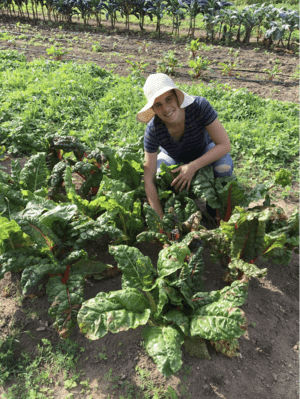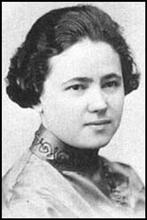Jewish Environmentalism
Women have been central to the development of Jewish environmentalism in the United States. They founded organizations like the Jewish Climate Action Network, started projects like the Jewish Greening Fellowship, wrote books on Jewish environmentalism, educated their communities through programs like the Teva Learning Center, grew food on Jewish community farms, and advocated for better policies at the local, state, and national level. These women saw their environmental ideals as directly connected to their Judaism. Working at the intersection of Judaism and environmentalism for decades, they have realized that our future may depend on this work in the face of the climate crisis.
Introduction
On a chilly weekend in February 2020, two young Jewish women, Shani Mink and Sarah Julia Seldin, gathered over 160 Jewish farmers and farm allies at Pearlstone Center in Reisterstown, MD, for “Cultivating Culture: A Gathering of Jewish Farmers.” The program included sessions on Jewish agriculture, racial justice, and climate change. The Jewish Farmers Network, founded in 2017, is a relatively new organization, but it is situated in an ever-growing network of contemporary Jewish environmental organizations that work at the nexus of Judaism and environmentalism. And when Mink and Seldin founded their organization, they joined a group of formidable Jewish women.
A Jewish Response to Climate Change
As the most marginalized communities on earth suffer the devastating effects of more powerful storms, more frequent fires, and more persistence droughts, it is clear that the climate crisis is upon us. More Jews than ever are engaged in climate activism but environmental activism has a longer history in the Jewish community. In the second decade of the twenty-first century, Jewish organizations have started national initiatives to “green” the world and take Jewish action in the face of these challenges. One of these efforts was the Jewish Greening Fellowship, a project of Hazon funded by UJA-Federation of New York. The Jewish Greening Fellowship was led by environmental psychologist and activist Dr. Mirele Goldsmith, a leader in the world of Jewish environmentalism for decades. The Jewish Greening Fellowship engaged 55 Jewish organizations including Jewish Community Centers, synagogues, and day schools in efforts to be more sustainable and to address the challenges of climate change. The program ran from 2009 to 2014 and was succeeded by Hazon’s national Seal of Sustainability program, helping Jewish organizations advance sustainability within their communities through education, action, and advocacy.
Goldsmith went on to found the Jewish Earth Alliance, a national organization advocating in the United States Congress for action on climate change. Goldsmith represented the Jewish community at the 2009 UN Climate Change Conference in Copenhagen and has helped organize Jewish coalitions for climate marches in New York City and Washington, D.C. Goldsmith also worked with Adriane Leveen and Hody Nemes to start the New York City chapter of another Jewish climate organization, the Jewish Climate Action Network (JCAN), co-founded by Rabbi Katy Allen in Boston in 2013.
JCAN strives to be a voice for climate change in the Jewish world by providing resources on climate change, engaging Jewish communities in climate campaigns, and building relationships with environmental and justice leaders. Its members focus on education, activism, and organizing as they work towards these goals. In addition to serving as the President of JCAN-Massachusetts, Rabbi Allen considers herself an “eco-chaplain,” and she also founded Ma’yan Tikveh, the Wellspring of Hope, a Jewish community in Boston that holds outdoor services and events throughout the year. In addition to the Massachusetts chapter and the New York City chapter, JCAN also has chapters in the Greater Washington, D.C., area and Georgia.
In 2020, Rabbi Jennie Rosenn, who previously served as Vice President for Community Engagement at the refugee assistance organization HIAS, founded Dayenu: A Jewish Call to Climate Action to focus on national Jewish climate advocacy. Dayenu, named to reflect the fact that Jews have had dayenu “enough” of the destruction of the world, seeks to build a multi-generational Jewish movement to confront the climate crisis through advocacy and political action.
Early Organized Jewish Environmentalism
The organized Jewish environmentalist movement in North America began in 1988 when Rabbi Ellen Bernstein, unable to find a Jewish organization dedicated to the environment, founded Shomrei Adamah, Keepers of the Earth. The mission of Shomrei Adamah was to make the ecological roots of Jewish tradition accessible in order to inspire Jews to care for the land. The organization brought together thousands of people and inspired countless others through educational materials, books, and rituals long after it closed in 1996.
An initiator of Jewish ecological awareness, Bernstein also helped revive the minor Jewish holiday Tu B’Shvat, the New Year of the Trees, through the innovative seders she held to celebrate the holiday. She hosted the first Shomrei Adamah Tu B’Shvat seder for 200 people in 1988 on the banks of the Schuylkill River in Philadelphia. The Tu B’Shvat haggadah she created, A New Year for the Trees, was published the same year. This seder is inspired by one created by seventeenth-century Kabbalists and is structured around their four symbolic worlds of action, emotion, thought, and spirit. Bernstein integrated this idea with the ecological dimensions of the four seasons (winter, spring, summer, and fall) and the four elements (earth, water, air, and fire). Throughout the seder, different fruits, nuts, and red and white wine are used to represent the four worlds, seasons, and elements. Every year updated editions of A New Year for the Trees, or other haggadot modeled on it, are used in Tu B’Shvat celebrations in homes and communities all over North America.
In addition to Bernstein’s important work on Tu B’Shvat, Shomrei Adamah also had a lasting impact on North American Jewry through its educational programs, which inspired hundreds to engage with the environment and the outdoors as Jews. The organization ran wilderness trips, and ten communities started local chapters to promote Jewish environmentalism. Shomrei Adamah also published educational materials, including the 1992 book Let the Earth Teach You Torah. Intended for adults and teens, this curriculum offered Jewish perspectives on the relationship between humans and the earth. Shomrei Adamah helped this ritual gain traction within liberal Jewish movements. The work of Shomrei Adamah—in conjunction with Bernstein’s speaking engagements throughout the country and stories printed and broadcast in Jewish and secular press, including National Public Radio—popularized the idea of Jewish environmentalism in Jewish institutions and homes.
When her work with Shomrei Adamah ended, Bernstein continued her efforts, through speaking engagements to Jewish communities and publishing her ideas. She edited the 1996 book Ecology and the Jewish Spirit and authored The Splendor of Creation, published in 2006. In 2020, she co-authored The Promise of the Land: A Passover Haggadah with Galia Goodman, connecting the Exodus story with the Jewish people and the land.
This era also saw the founding of two major Jewish environmental organizations whose work continues today. The Coalition on the Environment and Jewish Life (COEJL) was founded in 1993 as an initiative of the Jewish Council for Public Affairs. This organization represents the Jewish community in the National Religious Partnership on the Environment. COEJL focused on integrating Jewish environmental education, activism, and advocacy for policy change and seeking to mobilize the Jewish community to engage in its mission.
Another early Jewish environmental organization, the Teva Learning Center, had its first season in fall 1994. The program was founded by educator Amy Meltzer and began as a two-week outdoor environmental education program for students in Jewish day schools in the northeastern United States. Meltzer’s vision was carried forward by Nili Simhai, who served as the Director of Teva for the next fourteen years. Under her leadership, Teva grew into the leading Jewish environmental education program in North America. In addition, Simhai trained hundreds of Jewish educators in environmental education, many of whom continue to work in the Jewish environmentalism sphere.
Teva is now part of Hazon, the Jewish lab for sustainability, and is headquartered at the Isabella Freedman Jewish Retreat Center in Falls Village, Connecticut. Teva continues to offer programs in Jewish environmental outdoor education for thousands of students each year. Hazon’s Jewish Outdoor, Food, Farming, and Environmental Education (JOFEE) Fellowship now provides a framework for Jewish professionals to expand their training as environmental educators.
An Approach to Jewish Environmentalism
Dr. Hava Tirosh-Samuelson, Director of Jewish Studies and Irving and Miriam Lowe Professor of Modern Judaism and Professor of History at Arizona State University, is a leading scholar of Judaism and ecology. She has played an essential role in analyzing, popularizing, and actualizing Jewish environmentalism.
In 2002, Tirosh-Samuelson edited a volume entitled Judaism and Ecology, in which she wrote about the history of the Jewish environmental movement. Jews came to environmentalism relatively recently, and she notes that the early Jewish leaders in the environmental movement did not come to environmentalism through Judaism. Similarly, in Israel, where the environmental movement is popular among secular Israelis, the movement does not draw on religious institutions nor on religious sources. Tirosh-Samuelson proposed a few reasons for this disconnect. First, she notes that although traditional Jewish prayers express acknowledgement of and gratitude to the natural world, traditional Jewish thought has approached nature, without human input, as imperfect. Second, for much of Jewish history, Jews lived and worked in urban centers far away from the land. Finally, when environmentalism began to gain traction in North America in the 1960s, Jews were too preoccupied with the survival of the Jewish people in the wake of the Holocaust.
Tirosh-Samuelson identified a shift in the early 1970s, after the 1967 publication of Lynn White Jr.’s essay “The Historical Roots of our Ecologic Crisis,” which identified the idea of man having dominion over creation in the Biblical creation story as the source of Christian anthropocentrism and subsequently as the cause of the ecological crisis. This elicited a Jewish response. Early defenses came from Orthodox thinkers, suggesting that the essay was based on a misunderstanding of the sources. Jews from the Reform, Conservative, Reconstructionist, and Humanist movements added to the conversation and began building a small body of literature on Judaism and ecology. Tirosh-Samuelson pointed out that although early writing about Judaism and the environment came from religiously committed Jews, Jewish environmental activism began to take shape only when committed environmentalists began to explore their Jewish roots. This was particularly true of members of the Jewish Renewal movement of the late 1960s and early 1970s. Tirosh-Samuelson argued that the Jewish ecological discourse that developed through the writings of Jewish movement leaders and Jewish environmental activists revealed a “deep concern for the well-being of the natural world” in Judaism (p. xxxviii). Many of these early writers, thinkers, and activists were men and men continue to hold senior positions in many of the national Jewish environmental organizations. However, women like Hava Tirosh-Samuelson have played essential roles in analyzing, popularizing, and actualizing Jewish environmentalism.
Jewish Community Farming
In 2004, a new branch of Jewish environmentalism started at the Isabella Freedman Jewish Retreat Center with the founding of Adamah, a farm and fellowship program. Since then, over twenty Jewish community farming organizations have been founded across North America. These organizations use farms and gardens as educational spaces to enact Jewish environmentalism. The organizations vary widely, as each organization was founded to address the specific needs of its local Jewish community, though all share a commitment to environmental and food justice. Many women actively work at all levels in this movement.
As of 2021, Janna Siller, as farm director at Adamah, oversees production on the farm and supervises the farm fellows who grow food for the retreat center kitchen. Farm fellows also produce jam and pickle product lines and run a Community Supported Agriculture (CSA), farmer’s market stands and a local soup kitchen. Siller is also a leader and mentor in the field for advocacy on agricultural issues. Shoresh Jewish Environmental Programs in Toronto, Ontario, is run by two Adamah alumnae, Risa Alyson Cooper, who serves as Executive Director, and Sabrina Malach, who is the Director of Engagement. Cooper and Malach focus their educational programs and their work on the land on environmental stewardship and pollinator repopulation.
Ganei Beantown in Boston was founded by Leora Mallach and Becca Gan Levy to offer environmental education to the local Jewish community. As of 2021, Mallach serves as the organization’s executive director and connects Jews to the land and to Jewish agricultural traditions. Gan Levy is farm and sustainability director at Milk and Honey Farm at the Boulder Jewish Community Center in Colorado. Here she brings people together with plants, animals, and soil to strengthen their health and the health of their community. Sue Salinger directs Hazon’s program in Denver, including Ekar Farm, an urban farm inspired by Jewish values, founded by Amy Berkowitz Caplan. Salinger previously served as director for Hazon Detroit and is dedicated to agricultural initiatives that address food insecurity. Nili Simhai, former Teva director, serves as director of Outdoor Education for Abundance Farm in Northampton, Massachusetts.
These women and many others have helped grow the Jewish community farming movement into a diverse and robust collection of organizations that encourage Jews to get their hands dirty and help build a more sustainable food system.
Conclusion
One of the last sessions at the gathering of Jewish Farmers in February 2020 focused on the biblical agricultural sabbatical year, known as the shmita year. It focused on ways that Jewish farmers might incorporate shmita into their work to confront the contemporary climate crisis with the ancient wisdom of collective action, release, and reinvention. Participants at the conference used Jewish sources and values to envision large-scale systemic solutions to address the climate crisis.
As they engaged in this work, the participants and the conference organizers Shani Mink and Sarah Seldin followed in the footsteps of the Jewish environmentalist women who came before them. Founding their organizations, writing their books, educating their communities, growing food, and advocating for better policies, these “forebears” of the movement saw their environmental ideals as directly connected to their Judaism. Working at the intersection of Judaism and environmentalism for decades, they have realized that our future may depend on this work.
Benstein, Jeremy PhD. The Way into Judaism and the Environment. Woodstock, VT: Jewish Lights Publishing, 2006.
Bernstein, Ellen, ed. Ecology & the Jewish Spirit: Where Nature & the Sacred Meet. Woodstock, VT: Jewish Lights Publishing, 1998.
Bernstein Ellen and Dan Fink. Let the Earth Teach You Torah. Philadelphia, PA: Shomrei Adamah, 1992.
Bernstein, Ellen and Galia Goodman. The Promise of the Land: A Passover Haggadah. Millburn, NJ: Behrman House, 2020.
Bernstein, Ellen. The Splendor of Creation: A Biblical Ecology. Cleveland: Pilgrim Press, 2019.
Isaacs, Ronald H. The Jewish Sourcebook on the Environment and Ecology. Northvale, NJ: Jason Aronson Inc., 1998.
Jacobs, Mark X. “Jewish Environmentalism: Past Accomplishments and Future Challenges.” In Judaism and Ecology: Created World and Revealed World, ed. Hava Tirosh-Samuelson, 449-480. Cambridge: Harvard University Press, 2002.
Krone, Adrienne. “Growing Food: Ecological Ethics in the Jewish Community Farming Movement.” In Feasting and Fasting: The History and Ethics of Jewish Food, ed. Aaron Gross, Jody Myers, and Jordan Rosenblum, 273-286. New York: NYU Press, 2019.
Tirosh-Samuelson, Hava. “Introduction” in Judaism and Ecology: Created World and Revealed World, ed. Hava Tirosh-Samuelson, xxxiii-lxii. Cambridge: Harvard University Press, 2002.
White, Lynn. “The Historical Roots of Our Ecological Crisis.” Science. 155 (1967): 1203-1207.












